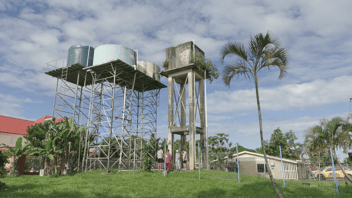Working with schools to conserve water in Indigenous communities
Partnering with schools has huge potential to drive behavioural change in Indigenous communities and Ozwater’21 delegates gained insight into the success of the That’s My Water! program developed by Power and Water Corporation in partnership with Atria Group.
Power and Water Corporation Strategic Project Manager Kylie Climie said educating school students about water conservation is an important component of creating lasting benefits for demand management.
“The Northern Territory is a big, expansive place. Thirty per cent of the population in the NT identify as Aboriginal, and 70% of that cohort live in Aborigianal communities, out on Country,” she said.
“When it comes to demand management, we’ve realised that there are four types of water that we use. These include network losses, customer leaks, excessive water use and normal water use.
“In demand management for network losses and customer leaks, often we can find big, quick wins. These rely on our business, or intergovernmental relationships.
“But there is an element of customer leaks and excessive water use that really rely on our ability to develop relationships with communities.
“This is fundamental. We need to develop relationships to drive change. And often the change is not only to potentially meet that water demand for the community, but also to enable growth and development.
“We are often faced with situations where development applications come in, but we don’t have the water to meet them. But we can keep working towards driving down demand to enable these important developments.”
Power and Water Corporation’s That’s My Water! program is a learning experience designed to take students, parents and teachers on a journey to learn about where our water comes from and how important it is to save water.
“Through the That’s My Water! school program, we’ve been able to build relationships and expand our footprint within remote communities,” Climie said.
“The school children wrote a song about water. It was about finding leaks, and was really embraced by the community.
“Essentially, the That’s My Water! program helped us develop relationships to enable a reduction in demand for various types of water use. The program empowers people with information and provides them with opportunities to get involved and be active in their water management story.
“We don’t want people to be using no water, we want people to be using water in the best possible way to enable their future growth, their health and their wellbeing.”
Atria Group Head of Education, Insights and Engagement Patrick Naughtin said water organisations interested in genuine and lasting behavioural change should be seeking opportunities with local schools.
“There is huge potential in engaging the education system. Having a schools program shouldn’t be a nice, to-do thing. It should be a corporate decision, one in which returns are measured,” he said.
“About 40% of the population have weekly contact with their local school, highlighting that schools really are a community hub. It’s the number one trusted social institution in communities.”
While school programs are nothing new, Naughtin said the question is about how to do it, and how to do it well, which depends on the unique needs of each community.
“Organisations have a lot of things to offer that are of value to schools. But corporate priorities are not educator priorities. The language used needs to communicate with what schools are already doing,” he said.
“This includes things like curriculum alignment, elite resources, and offering a point of difference. Schools are busy places and it’s important to compete effectively within these dynamic and time-limited environments.
“Schools are crying out for local, real-world engagement opportunities. But different communities have different priorities. Both-ways learning puts traditional knowledge at the heart of designing education experiences.”


